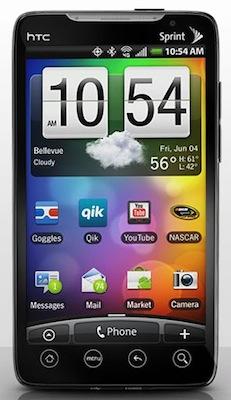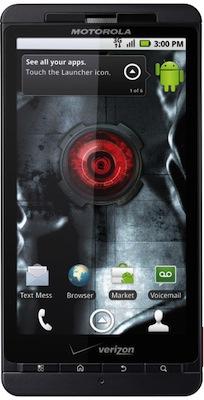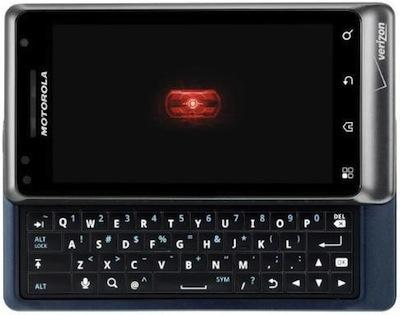You've seen our "Best Smartphones" list that's ranked by carrier, but that's only half of the story. This week, I'm focusing on Android with my top five Android smartphones list, ranked by device and not by carrier. It's important to note two things - (1) there are a lot of great Android devices that didn't make the list, and (2) this list applies to today and today only, as I have no idea what I'll think next week, next month, or next year. At the pace in which Android devices are coming out, I'm sure the list will be different next week. As always, let me know what you think in the comments section!

Where it excels: G2 effectively replaces the G1 and Nexus One as the new flagship device for those that want a vanilla Android 2.2 (Froyo) experience. The grey colors and metal accents make the device appeal to all demographics, and beyond that, it's zippy - an 800 MHz next-gen Snapdragon processor means that everything runs smoothly and without lag. The G2 has the best physical QWERTY keyboard I've ever used on an Android device, and within minutes, I was pounding out text messages without delay. It's 3.7-inch display hits the sweet spot between "tiny" and "wow, that phone is huge," even though it weighs a hefty 6.5 ounces.
As if that wasn't enough, the G2 is T-Mobile's first device to support HSPA+, the supercharged 3G network that they're rolling out in response to 4G. Theoretically, it offers speeds of up to 21 Mbps, though I've been unable to get anything over 5,500 Kbps in both Charlotte and San Francisco.
Where it falls short: G2's hinge is a bit loose, and separates from the device when you're holding it upside down. I can't say that it bothers me, but for those that text message in bed, on the couch, or anywhere else that requires you to hold it above your head, you're out of luck. On a more pressing note, two of the three G2's I've worked with all have dead pixels, and I've heard similar comments from G2 users.
The verdict: Spec for spec, this is the Android device I would buy if I was in the market right this second.

Where it excels: Announced at CTIA 2010 in March and released in June, the HTC EVO 4G is an awesome blend of power. 1 GHz processor, 4.3-inch screen, 8.0-megapixel camera with 720p video recording capabilities, and Android 2.2 with HTC's Sense user interface. I'm a fan of the manufacturer-installed overlays for several reasons, and HTC's Sense UI appeals to everyone from the first-time buyer to smartphone addicts.
Software aside, EVO is one of Sprint's 4G-capable smartphones, so that's a nice benefit. Still, Sprint's 4G service isn't available everywhere, and there's a $10 monthly "premium data" charge that's assessed in addition to the typical plan pricing.
Where it falls short: Early models were suffering from build issues like light leakage around the screen, general screen issues, and battery life problems.
The verdict: Four months after its retail release, the EVO 4G continues to be a flagship Android device. The Android 2.2 update made it even better.

Where it excels: Outside of the typical high-end specs (1 GHz processor, 8-megapixel camera, here the DROID X stands apart from the crowd is its multitouch keyboard. I often type faster than most on-screen keyboards can keep up, and the DROID X is one of the few devices that can keep up with me. I happen to love the industrial design and brash widgets found in MOTOBLUR, and prefer the long and narrow screen to the EVO's short and wide one.
Where it falls short: It competes with the EVO 4G, Samsung Epic, yet it's missing the front-facing camera. For all I know, it could be a novelty that wears off in a few years, but at the moment, it's quite the hot novelty. It's also experiencing some minor software issues since the upgrade to Android 2.2, most notably in the text messaging order.
The verdict: If a physical keyboard doesn't matter to you, this is the must-have Android device on Verizon. Keep an eye out though, as the holiday season looks to be a busy one for Verizon.

Where it excels: The most feature packed of Samsung's Galaxy S line, the Epic 4G sports a 1 GHz processor, 4-inch "Super AMOLED" display, 5-megapixel shooter, and a front-facing camera for video calling. The physical QWERTY is one of the best I've used, and I enjoyed using it for the occasional video chat.
Where it falls short: Epic 4G is subjected to the same $10 monthly data add-on as the EVO, and it takes longer to charge than other Android phones. Not a big deal, but noticeable when you're charging 20-30 minutes at a time. At $249.99, it's slightly outside of the $199.99 price point that consumers are used to, despite Sprint's cheaper service plans.
The verdict: It's a nice device with a lot of great features, though Samsung's colorful iPhone-ish TouchWiz user interface isn't for everyone. It's also one of the few remaining high-end devices that hasn't been updated to Android 2.2. It's expensive up front, but you'll probably save money in the long run with Sprint versus Verizon or AT&T.

Where it excels: Take the DROID X, condense it, add a physical QWERTY keyboard, kill off a few megapixels on the camera, and you have the DROID 2. Replacing the original DROID, it has an improved keyboard, less of an in-your-face design, and packs Android 2.2 with MOTOBLUR. The DROID 2 packs a 1 GHz processor (noticing a trend here?), so it's faster than the original DROID in typical tasks.
Where it falls short: Initial units suffered from signal strength and battery life issues. This doesn't bother me per se, but Android junkies that prefer a vanilla experience will be frustrated with DROID 2's MOTOBLUR overlay. To that point, I refer you back to device number one on my list.
The verdict: Like the G2, but want to stay with Verizon? The Motorola DROID 2 is the device for you.